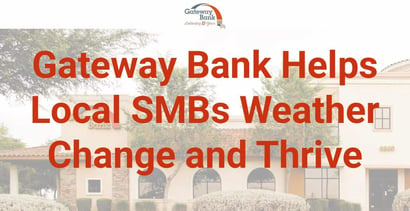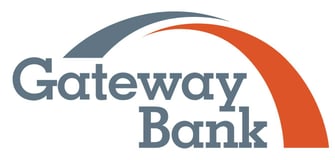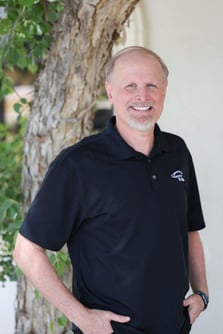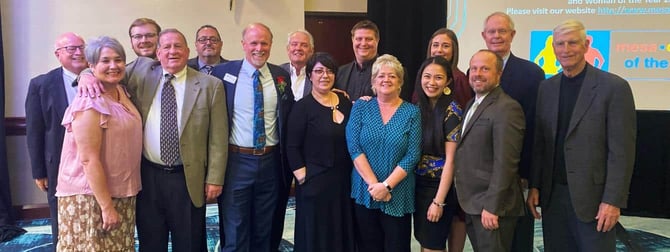
In a Nutshell: During the period of heightened bank failures in early 2023, James Christensen, President and CEO of Gateway Bank in Mesa, Arizona, issued a video message to reassure local businesses that their money remained safe. Christensen’s statement exemplifies Gateway’s commitment to helping businesses in the Mesa area continue to provide jobs and community presence in good times and bad. The team’s flexibility has kept businesses up and running through the Great Recession of 2007-08 and the COVID-19 pandemic, so SMBs banking with Gateway know the bank has their back.
No matter the economic climate or the stresses on businesses, the tight-knit team at Gateway Bank, based in Mesa, Arizona, and led by President and CEO James Christensen, goes above and beyond to keep commerce up and running and people moving forward.
That commitment stems from Gateway’s status as the only community bank in Mesa and a stalwart for local growth for 16 years, since before the economic downturn of 2007-08, known as the Great Recession. The bank continued to provide continuity through the COVID-19 pandemic as businesses closed and residents endured shutdowns.

It’s a record of success that would have been impressive even without the financial consolidation in the state over the years. When Gateway started, Arizona was home to almost 60 distinct bank charters. Only 12 institutions call the state home today, with no new banks opening after Gateway until 2022.
Yet Gateway has endured as a small business and community supporter through thick and thin, dedicated to the success of every entrepreneur and job creator. Christensen said that’s due to Gateway’s community bank status, which differentiates it from more impersonal large banks.
“To this day, after 16 years and going through the Great Recession and COVID, we’ve had three foreclosures and one business failure in our entire existence,” Christensen said. “I think with big banks, there would have been a tremendous number of our companies that didn’t make it.”
But because Gateway stuck it out with its business clients through downturns and changing times, many are significantly larger than when they started and are making good money. That, in turn, helps area residents who need jobs contribute to recovery and growth in Mesa.
“You just kind of hang in there,” Christensen said.
Teamwork and Flexibility Build Enduring Relationships
Christensen likens his stewardship of Gateway to a parenting role. When a child in a healthy family strikes out on their own to attend college or begin a career, they don’t have the fear of experiencing homelessness or even missing a meal because they have family back home to act as a backstop.
“I look at our bank as the backstop for our clients,” Christensen said. “The last thing I want to do is take a company or a piece of real estate back, and it’s only in a last-case, last-resort scenario where that would ever happen.”
All that’s required, Christensen said, is certainty that things will work out for the best in the long run. Big banks tend to move in and out of business verticals according to what the numbers demand. But the small but dedicated and tight-knit team at Gateway avoids making rash decisions, opting for a steady approach.

Many team members have been with the bank for a decade or more. It’s as if Christensen were George Bailey in the famous Christmas movie “It’s a Wonderful Life,” except that Gateway brings the same teamwork and dedication to the table daily.
Most of Gateway’s work is with local businesses: business banking comprises about 95% of its lending portfolio. It’s fitting that the small amount of personal banking Gateway undertakes mainly supports business clients and their families.
As long as the client exhibits the same strong character as Christensen, there’s rarely a limit to what Gateway will do to support them. For example, a local gym forced to shut down during the pandemic relied on Gateway for flexibility to tide them over until restrictions ended.
“We can be pretty flexible with our clients, and it’s incredibly rare that we have a payment issue,” Christensen said. “I think the last loan we had a problem with was in 2017.”
Training and Mentoring Sets SMBs Up for Growth
But maintaining that commitment and success with business customers requires more than sound banking. Christensen and senior members of the Gateway team feel called to reach out to the community as trainers and mentors through various outlets.
One outlet for that outreach is the HUUB entrepreneur resource platform, a product of the CO+HOOTS entrepreneur resource center based in nearby Phoenix, Arizona.
At HUUB, Christensen and colleagues work with cohorts in a virtual accelerator environment to outline the essential differences between community banks like Gateway and enterprise-level banks, and impart financial fundamentals critical to running a business.
Christensen said that although big banks account for at least 70% of business in the Phoenix area, founders and entrepreneurs will find they have advantages when they turn to institutions with a local emphasis.

“A lot of folks think that if they have an issue with a big bank or have been turned down by them, they’re done,” Christensen said. “After 37 years in banking, I still get amazed that people are shocked about the differences between community banks and large banks.”
SEE ME is an example of other work Gateway supports. Spearheaded by Gateway team member Shellie Berry, SEE ME stands for Social and Economic Equity for Minority Enterprises. In 2022, the program began shepherding about 20 minority entrepreneurs through an 18-month course to support, track, and elevate their prospects.
“We’re ultimately just going through what it means to have a relationship with a banker,” Christensen said. “It’s always fun when you do those because you get really good questions, and the sessions tend to run long.”
A Personal Approach to Business Banking
Christensen said he spends more time in these outreach and support roles than ever. For example, he performs training and mentoring work through SEED SPOT, a nonprofit devoted to encouraging businesses with social impact.
Christensen also works extensively with the Mesa Chamber of Commerce as leader of the Mesa Financial Network, a cohort of area financial professionals who aim to improve the economic and community effectiveness of financial services. He also participates in the chamber’s Capital Opportunity Program, which seeks to match local entrepreneurs with financial support.
He’s also a frequent speaker at local business and chamber group sessions, leading the way to help area founders realize their potential to provide good jobs and energize the community.
“Whether it’s a roundtable with bankers and venture capital people or a women’s business group, I probably spend 10-15% of my time doing teaching and outreach, which is drastically different from what it used to be,” Christensen said.
All of these efforts stress the essential difference between community banking and banking by numbers, which comes down to availability. Gateway has financial relationships with about seven of the 20 SEE ME cohort members receiving support and works with three on early-stage planning.
“Much of our work is networking and connecting and helping them craft the business plan that makes the most sense,” Christensen said. “I wouldn’t be surprised if some of them are still 12 to 24 months out from executing their plans, but this work comes in handy.”
Meanwhile, community outreach also takes on a philanthropic cast at Gateway, with the bank supporting many area charities, schools, and service organizations. It shows that good things happen when a bank is committed to the community, as only a community bank can be. Christensen said it’s a vital component of the bank’s success. George Bailey would be proud.
“Before the pandemic, we were a $120 million bank, and we’ve almost doubled that,” Christensen said. “The more authentic and real we are, the more we’ve grown.”






